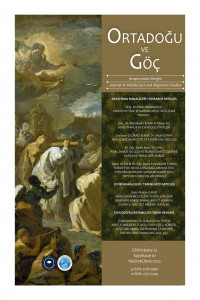KAMU TAHAYYÜLÜNDE KADIN MÜLTECİLERİN TOPLUMSAL DIŞLANMASI: YETERSİZ TEMSİL VE KİŞİLİKSİZLEŞTİRME
Temsil, Kadın Mülteciler, Suriyeliler, Sosyal İçerme, Sosyal Dışlama, Haber Fotoğrafları, Representation, Women Refugees, Syrians, Social Inclusion, Social Exclusion, News Photographs
SOCIAL EXCLUSION OF WOMEN REFUGEES IN PUBLIC IMAGINATION: UNDERREPRESENTATION AND DEPERSONALISATION
Representation, Women Refugees, Syrians, Social Inclusion, Social Exclusion, News Photographs,
___
- Amores, J.J., Arcila-Calderón, C. and González-de-Garay, B. (2020). The Gendered Representation of Refugees Using Visual Frames in the Main Western European Media. Gender Issues, (37), 291–314.
- Amores, J. J., Arcila, C., and Stanek, M. (2019). Visual Frames of Migrants and Refugees in the Main Western European Media. Economics & Sociology, 12(3), 147–161.
- Alhayek, K. (2014). Double Marginalization: The Invisibility of Syrian Refugee Women’s Perspectives in Mainstream Online Activism and Global Media. Feminist Media Studies, 14(4), 696–700.
- Bell, P. (2001). Content Analysis of Visual Images. in Handbook of Visual Analysis (pp. 10-34). London: Sage.
- Berger, J. (1972). Ways of Seeing. London: Penguin Books
- Bleiker, R.; Campbell, D.; Hutchison, E. and Nicholson, X. (2013). The Visual Dehumanisation of Refugees, Australian Journal of Political Science, 48(4), 398-416.
- Bock, M. A. (2017). Visual Communication Effects: Photography. In The International Encyclopedia of Media Effects. Hoboken, NJ: Wiley.
- Breen, M. J., Haynes, A., and Devereux, E. (2006). Fear, Framing and Foreigners: The Othering of Immigrants in the Irish Print Media. International Journal of Critical Psychology, 16, 100–121.
- Chouliaraki, L., and Stolic, T. (2017). Rethinking Media Responsibility in the Refugee ‘Crisis’: A Visual Typology of European News. Media, Culture and Society, 39(8), 1162–1177.
- Doğanay, Ü. and Çoban Keneş, H. (2016a). Yazılı Basında Suriyeli ‘Mülteciler’: Ayrımcı Söylemlerin Rasyonel ve Duygusal Gerekçelerinin İnşası. Mülkiye Dergisi, 40(1), 143-184.
- Doğanay, Ü. and Çoban Keneş, H. (2016b). Hak Temelli Bakış Açısının Yokluğu ve Ayrımcı Söylemler Açısından Gazete Haberlerinde Mülteci Kadınlar. In Haber Okumaları (pp. 252-294). İstanbul: İletişim Yayınları.
- Efe, İ. (2019). A Corpus-Driven Analysis of Representations of Syrian Asylum Seekers in the Turkish Press 2011–2016, Discourse & Communication, 13(1), 48–67.
- Erdoğan, M. (2015). Syrians in Turkey: Social Acceptance and Integration Research. Hacettepe University Migrations and Politics Research Center. Retrieved online at https://data2.unhcr.org/en/documents/download/46184 on 05.10.2022.
- Global Media Monitoring Project (2020). Who Makes the News? Retrieved online at https://whomakesthenews.org/wp-content/uploads/2021/11/GMMP2020.ENG_.FINAL_.pdf on 29.12.2022.
- Geçici Koruma (2022) Göç İdaresi Başkanlığı. Retrieved online at https://www.goc.gov.tr/gecici-koruma5638 on 05.10.2022. Greenwood, K. and Thomson, T. (2019). Framing the Migration: A Study of News Photographs Showing People Fleeing War and Persecution. International Communication Gazette, 1-24.
- Greer, C. (2007). News Media, Victims and Crime. in Victims, Crime and Society. (pp. 20-49). London: Sage Publications. Humprecht, E., and Esser, F. (2017). A Glass Ceiling in the Online Age? Explaining the Underrepresentation of Women in Online Political News. European Journal of Communication, 32(5), 439–456.
- Johnson, H. L. (2011). Click to Donate: Visual Images, Constructing Victims and Imagining the Female Refugee. Third World Quarterly, 32(6), 1015-1037.
- Malkki, L. H. (1997). Speechless Emissaries: Refugees, Humanitarianism and Dehistoricization. in Siting Culture: The Shifting Anthropological Object. (pp. 223-254). New York/London: Routledge.
- Mannik, L. (2012). Public and Private Photographs of Refugees: The Problem of Representation. Visual Studies, 27(3), 262-276. Mert Elmas, Ş. and Paksoy, A. F. (2020). Türk Basınında Suriyeli Sığınmacı Kadınların Temsili. Türkiye İletişim Araştırmaları Dergisi, (35), 184-210.
- Narlı, N., and Özaşçılar, M. (2021). Representation of Syrian Women and Children Refugees’ Health in Turkish Daily Newspapers. Journal of International Migration & Integration, (22), 167–181.
- Narlı, N., Özaşçılar, M and Turkan Ipek, I.Z. (2020). Turkish Daily Press Framing and Representation of Syrian Women Refugees and Gender-Based Problems: Implications for Social Integration. Journal of Immigrant & Refugee Studies. 18(1), 1-21.
- Ross, K., and Carter, C. (2011). Women and News: A Long and Winding Road. Media, Culture and Society, 33(8), 1148–1165.
- Syria Regional Refugee Response. (2022). United Nations High Commissioner for Refugees (UNHCR). (2022). Retrieved online at https://data2.unhcr.org/en/situations/syria on 25.12.2022.
- ISSN: 2718-0980
- Yayın Aralığı: Yılda 2 Sayı
- Başlangıç: 2011
- Yayıncı: Kilis 7 Aralık Üniversitesi
THE CAUSES OF AFGHAN IMMIGRATION TO TÜRKİYE
GÖÇMEN SURİYELİ LİSE ÖĞRENCİLERİNİN MESLEK SEÇİMLERİNİ ETKİLEYEN FAKTÖRLER
Mustafa KARACOŞKUN, Mehmet ATEŞ
ORTA ASYA YAHUDİLERİ, TARİHLERİ VE KÜLTÜRLERİ
KAMU TAHAYYÜLÜNDE KADIN MÜLTECİLERİN TOPLUMSAL DIŞLANMASI: YETERSİZ TEMSİL VE KİŞİLİKSİZLEŞTİRME
HATAY-ANTAKYA’DA YAŞAYAN SURİYELİ SIĞINMACILARIN SOSYAL UYUMUNUN ÖLÇÜLMESİ
SURİYELİ MÜLTECİLERE UYGULANAN AYRIMCI-DIŞLAYICI TWİTLERİN BERT MODELİ İLE SINIFLANDIRILMASI
